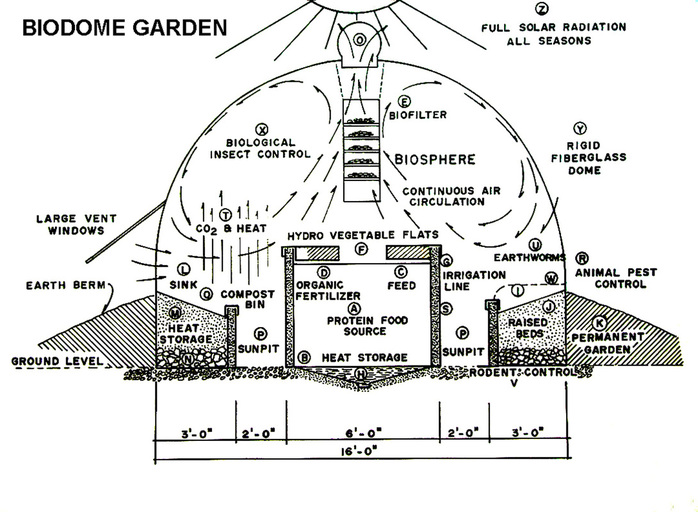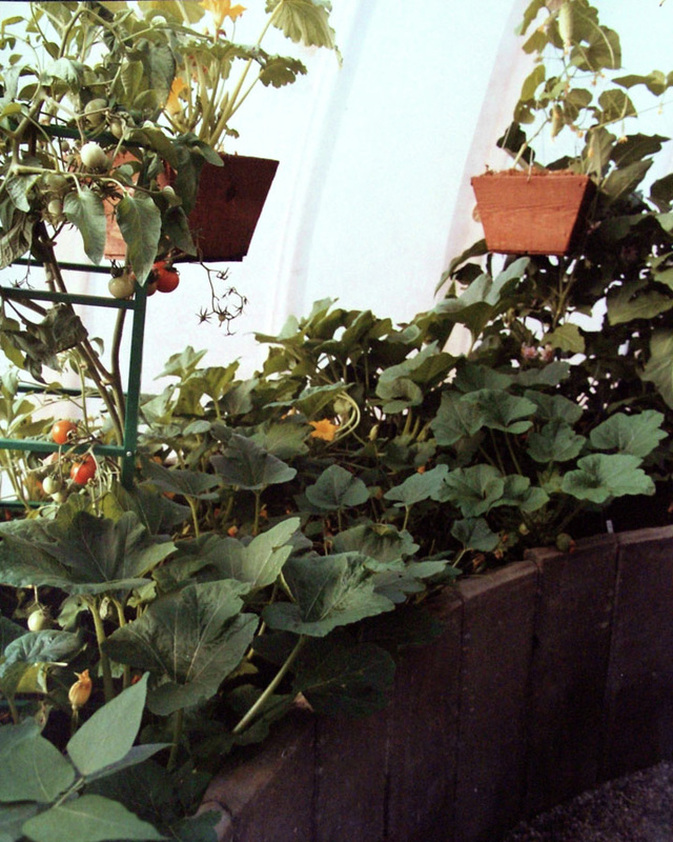PASSIVE SOLAR GREENHOUSE GARDENING IN A NUTSHELL
With passive solar systems, performance depends on correct design and construction, not just component reliability. In designing a passive solar system, certain heating rules of thumb must be followed. According to the Department of Energy, any passive solar greenhouse must include the following five elements in order to be considered a complete passive solar heating system eligible for tax credits: (1) a collector, (2) an absorber, (3) a storage mass, (4) a distribution system and, (5) a control system. The design of the Biodome Garden incorporates three of these, and the design of the Biodome Garden Room incorporates all five, making the system eligible for tax credits if the unit meets the Department of Energy criteria. A diagram of the layout and cross section of a Biodome Garden Room is included in THE BIODOME GARDEN BOOK.
THE FIVE ELEMENTS OF PASSIVE SOLAR HEATING
COLLECTOR: The translucent rigid fiberglass dome receives solar heat while giving optimum tilt both seasonally and daily. Because collectors achieve their maximum potential when tilted at a 90 degree angle to the sun's rays, the dome shape with its curved surface can hold this angle regardless of the position of the sun, and is therefore ideal for this purpose.
ABSORBER: The dark surfaces of the walls of the raised concrete vegetable beds and fish tank act as heat absorbers. The darker the surface, the greater the heat-absorbing ability. It is therefore suggested that these surfaces be constructed of darker concrete products. THE BIODOME GARDEN BOOK includes many varieties of wall structure concrete products that can be used effectively.
STORAGE MASS: The water in the 800-gallon fish tank of the Biodome Garden is the primary thermal storage area, employing an effective thermal storage medium. This quantity of water will absorb, and then release, the heat equivalent of 37 gallons of oil over a 150-day heating season. Other storage masses within the unit include the earth mass of the raised vegetable beds, the masonry walls of the vegetable beds and fish tank, and the 4" layer of dense rock beneath the Biodome Garden.
DISTRIBUTION SYSTEM: This is where the Biodome Garden unit as a stand-alone unit falls short where tax credits are concerned, as the unit is not attached to the house and cannot be considered for supplementary home heating. However, the Biodome Garden Room fills this requirement as it is designed to attach directly to the house, preferably to the kitchen for convenient access to fresh herbs and vegetables at the cook's fingertips. With this design, natural convection flow and/or one small fan (optional) allows heat trapped within the Biodome Garden Room to flow into the adjoining house. Adaptation of the Biodome Garden to the Biodome Garden Room is addressed more thoroughly in THE BIODOME GARDEN BOOK.
CONTROL SYSTEM: The wind-powered turbine at the peak of the fiberglass dome draws in outside air through the ventilating windows in the unit and allows excess heat to be removed during the warm season. The hotter the air inside the dome, the faster the wind turbine turns. Constant evaporation of water in the fish tank also aids in cooling the unit during the summer, while the water actually absorbs some of the excessive heat and thereby helps in the cooling process. Conventional greenhouses require elaborate systems of fans and thermostats and humidifiers to do what this simple dome-wind-turbine design does naturally. The five elements of a passive solar greenhouse are addressed in depth in THE BIODOME GARDEN BOOK.
Vegetables thrive in the temperate, moist environment maintained inside the Biodome Garden. The gentle air flow created by the wind turbine is conducive to growth as the plants are never whipped about by wind or fans, and unlike glass, which allows direct rays of the sun through, the fiberglass dome scatters the rays into what is known as a diffuse pattern, which is preferable for plant growth.



